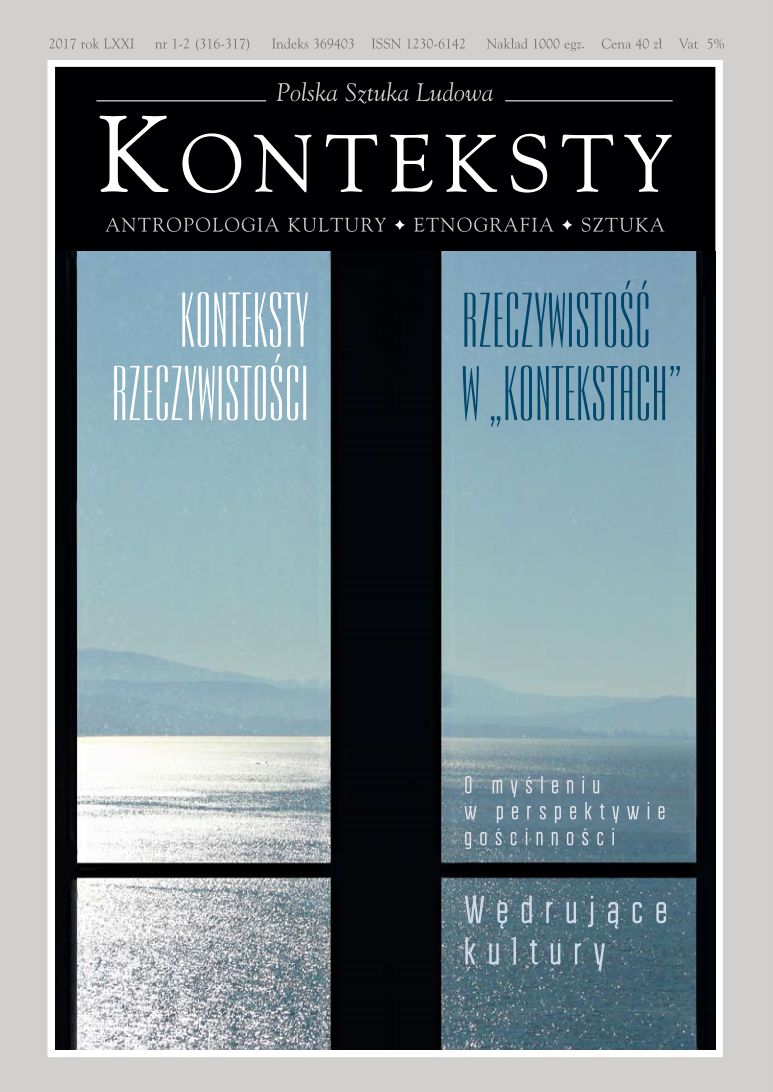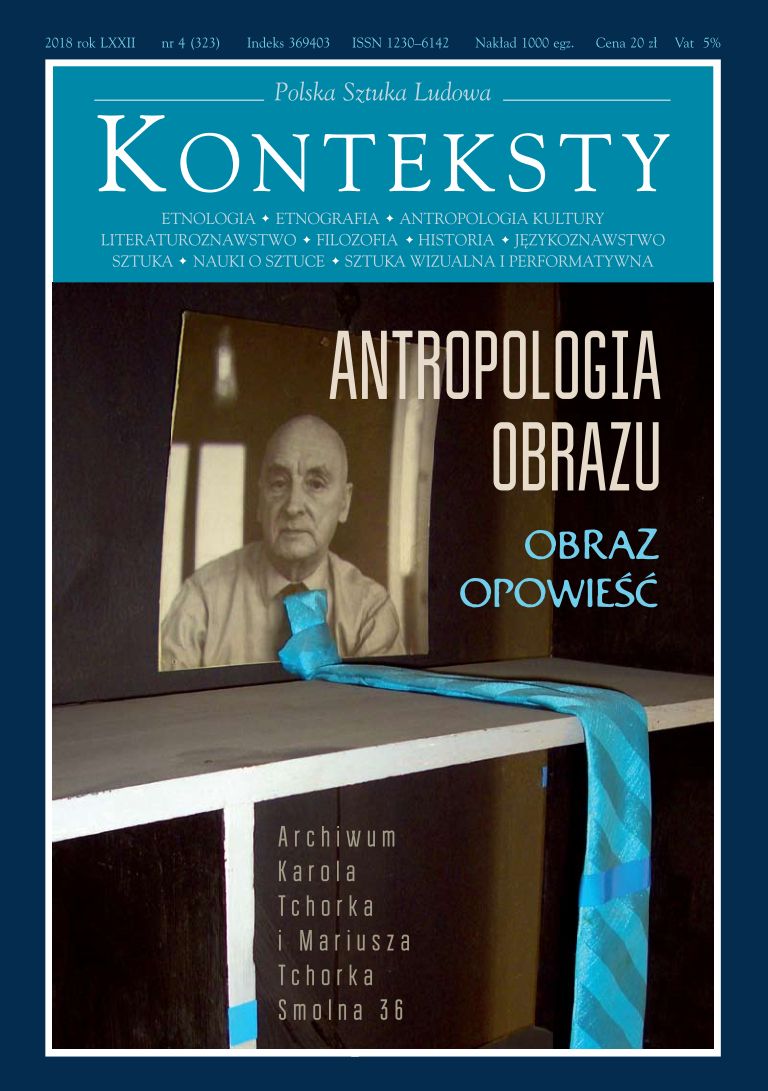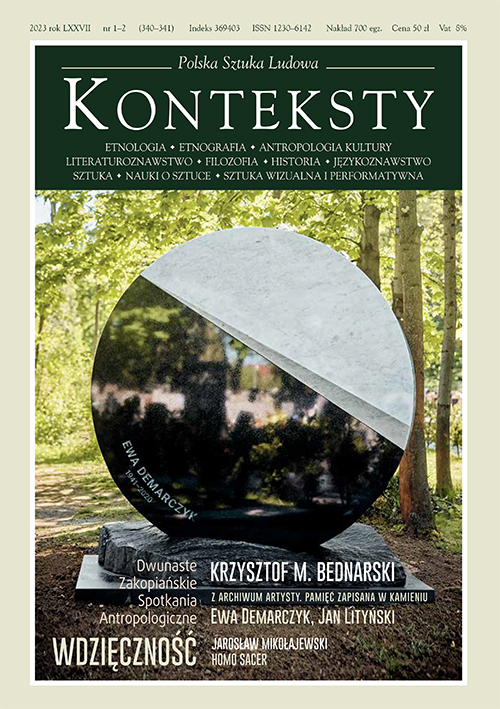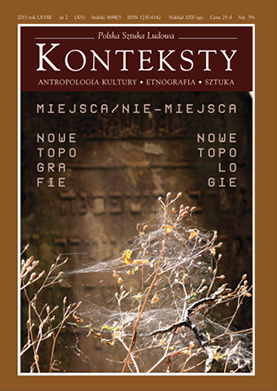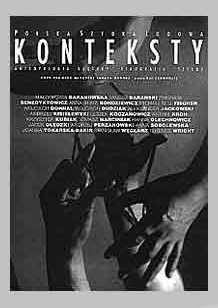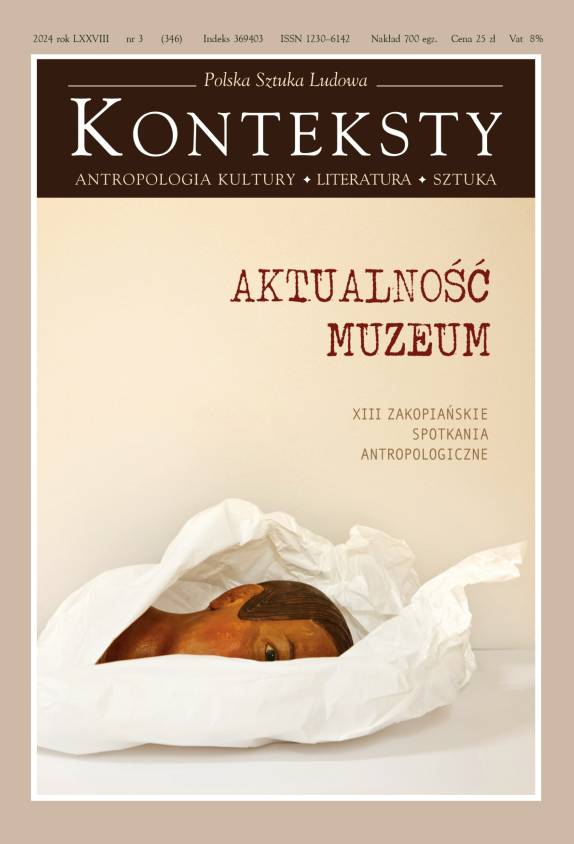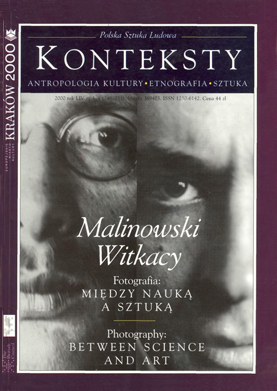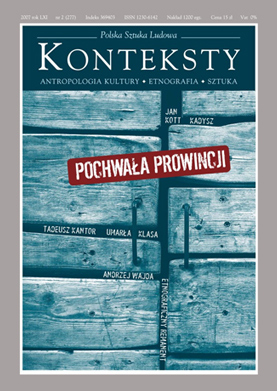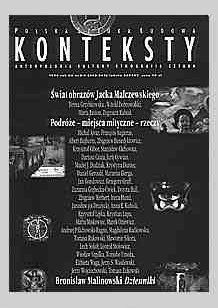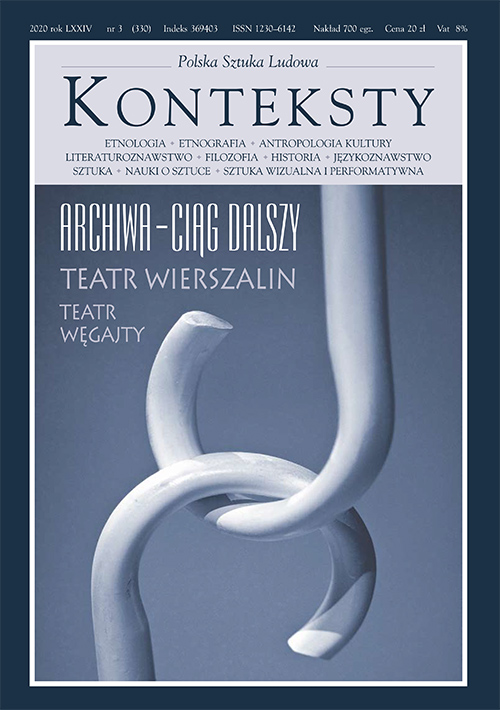Issue 2002/3-4 (258-259) - Carnival. Life and Literature

| Zbigniew Benedyktowicz | Carnival. Life and Literature | |
| Dariusz Czaja | Life or Non-transparency.Beyond the Anthropology of Culture  | |
The category of “culture" is one of the most frequently used (and abused) terms in anthropology. Its application is by no means epistemologically innocent but upon each occasion embroils the researcher into a wider context of methodological and even philosophical conjectures. Its employment in an anthropological context carries a frequently unconscious burden of positivistic premises, despite universal declarations about an anti-positivistic breakthrough. As a rule, “culture” relates to that which can be “objectively” examined and proven, and penetrates those spheres which science deemed suitable to study. The author suggests a return to the rather forgotten category of ,,life" conceived by Wilhem Dilthey as well as enlivening the conceptions expounded by representatives of the so-called philosophy of life (Bollnow, Misch, Simmel). Moreover, he demonstrates that “life” is a category much more capacious than culture despite the vaccilating nature of meanings, and much more useful in interpretative anthropology. It extracts from examined reality not only the semiotic aspect but also the existential and metaphysical dimension. By depicting both the simplicity and convoluted nature of the category of “life” the author refers to Life. A Manual, the novel by George Perec, and upon the basis of several selected motifs presents his theses about the non-transparent nature of life envisaged as a horizon that still evades scientific thought. | ||
| Commentaries and Polemics | ||
| Wojciech Michera | The Culture, Empathy and Technics of Slicing up | |
| Wiesław Szpilka | Live and Let Live | |
| Czesław Robotycki | Hremeneutics and Life on the Margins of Dariusz Czaja’s Considerations | |
| Dariusz Czaja | A few Questions cocerning Life | |
| Antoni Kroh | The Old River Valley. The Prince. Telephones. The Clock  | |
Three recollections, three refined and concise “pictures from the past” comprise a fragment of a book whose author referred to his own biographical memory. The select examples exceed mere sentimental “memoirs”. The author offers the reader not only a delectable anecdote and a glimpse of the manners and morals of the past, but also demonstrates the way in which History becomes amazingly intertwined with the private and unique history of an individual. | ||
| Events | ||
| Aleksandra Melbechowska-Luty | Akin to a Jewel in His Crown  | |
A me stresso is the title of an exhibition of paintings by Jacek Sempoliński organised in the Warsaw Zachęta Gallery and crowning the heretofore oeuvre of the artist. The review discusses works featured in the showrooms and comments on the form of the display - impressive, well-conceived and rendering the exhibition a theatrical spectacle of sorts. The second part of the text presents Sempoliński's book Władztwo i slużba (Dominion and Service), a collection of 89 texts from 1958-2001, brilliant “miniatures” about art written in a definitive and concise style. | ||
| Krzysztof Czyżewski, Michał Jagiełło, Bożena Żółtowska | Polish Folk Art by Aleksander Jackowski | |
| Ethnology Today | ||
| Victor Turner | Are there universals of performance in myth, ritual, and drama?  | |
This essay is a further step in the process of exploring some of the interweavings of ritual and theatre, a process Victor Turner had been exploring for some time. In 1980, Turner articulated very clearly what he saw as the goal of his writings. He stated: “Cultures are most fully expressed in and made conscious of themselves in their ritual and theatrical performances. A performance is a dialectic of flow, that is, spontaneous movement in which action and awareness are one, and reflexivity, in which the central meanings, values and goals of a culture are seen in action, as they shape and explain behavior. A performance is declarative of our shared humanity, yet it utters the uniqueness of particular cultures. We will know one another better by entering one another's performances and learning their grammars and vocabularies”. In Are there universals of performance in myth, ritual, and drama? Turner presented his Utopian vision of world community based on mutual respect and enjoyment of cultural differences, exchanges of feelings as well as ideas, and the increasing ability of people to experience and re-experience. He discussed a characteristic developmental relationship from ritual to theatre, and he presented the relationship of both to social drama. All figures in this essay express schematically some of these connections. | ||
| Jerzy S. Wasilewski | Travelling Ethnology 3 The Reindeer-People,the Taiga-People, Just People...  | |
The Caatans - a formerly isolated group of reindeer-breeders in the north of Mongolia. Some 300 people at the edge of extinction. Loosing the feeling of their ethnic identity (they are originally a group of Tuvans, who have escaped from Soviet Tuva in 1944), they call themselves simply “Taiga-People”, whereas the Mongols label them “Reindeer-People”. Political and economical changes of the 90-s made them available for research, tourism - and vulnerable to the impacts of a strange modernisation, being in fact a “retrogression to tradition”. After a total collapse of planned economy, forced sedentarisation, mandatory education and health protection system, they are left alone, facing most serious problems of biological and cultural survival. Unsupported, they returned to the old nomadic lifestyle, based on reindeer breeding and hunting, in tipilike tents. Old folkways are reintroduced. After the removal of the political ban, a renaissance of shamanism is noticeable. Four Caatan / Tuva shamans are active, their silhouettes are presented and their seances described in the paper. | ||
| Filip M. Taranienko | Music as speech and speech as music: an essay for comprehension of the same nature of both activities.  | |
In this essay the author tries to explain the similarity between the activities called in our everyday life “speech” and “music”. He suggests that the border between them is fluid. He passes over all the opinions dividing “language” and “speech”, considering all language firstly as a spoken or imagined word. He analyses some moments from the whole of human history which can tell us about people's attitudes towards speech and music, such as inventions of musical and linguistic writing systems, opinions of some philosophers, poets and musicians, and finally liturgical usage of languages, being for him a very important point. Liturgy is considered as a pattern situation for all other human activities connected with communication, speech and art, and in this way also as a base for analysis of the nature of examined notions. The text is divided into two parts: the first part examining the problem from the linguistic point of view and the second from the musical one. The first part concerns the intonation in everyday, poetic and liturgical language and the Semitic invention of alphabet, changed and accepted by Greeks. The second one contains some remarks about oral tradition in liturgical music and the first attempts to write it down; it presents some reflections of contemporary musicians executing early music, in particular medieval and baroque, trying to perform it in conformity with aesthetics of the times. The two parts are separated by a short reflection on the nature of memory, an indispensable condition of both music and speech. The conclusion is a moral one. It avoids repeating the introductory thesis. Of course, the problem needs some more reflection to be better understood. | ||
| Piotr Machul | The Gardzienice Manuscripts  | |
In this text, referring to the “Gardzienice” Centre for Theatrical Practice - the prime theme of the previous issue of “Konteksty” - the author tries to analyze, upon the basis of select examples, the “Gardzienice manuscripts”, i. e. the endeavours made by actors to create their own musical record in the course of theatrical ventures. Music was registered, at least partially, from the very onset of the “Gardzienice” group, but attempts at registering it grew intensified at the time of work on the latest spectacle - Metamorphoses after Apuleius. Upon the request of Maciej Rychły, responsible for the musical score of this particular production, almost every actor created an auteur musical record. The “manuscripts" are not, however, a universal code for deciphering classical music. Nor are they an ultimately defined and meticulously devised code, but remain merely an extremely interesting and original attempt at recording certain elements of the actors' training - predominantly musical and vocal. The “Gardzienice manuscripts” make it possible, at least to a degree, to follow the paths of musical motifs rendered indelible centuries ago on stone or papyrus, described in Martin West's Ancient Greek Music, and partially reconstructed for the needs of the “Gardzienice” Theatre. | ||
| Robert Darnton | Introduction to the Great Cat Massacre  | |
The renowned American historian proposes a masterly historical analysis of an incident that took place in eighteenth-century France. At the end of the 1730s a Parisian printer's workshop became the site of an unprecedented all-night massacre of cats committed by apprentices. In his meticulous reconstruction of the whole event Darnton tried to explain the reasons for the incident, its determinants and potential. Since the author is an historian of mentality his analysis is not limited to a mere critique of sources and the establishment of “what really took place”. By making extensive use of ethnographic sources and documenting the folklore backdrop of the demonisation of cats as well as their links with magic and sorcery, Darnton convincingly shows why the cats suffered their cruel fate and why a duel between the workers (plebeians) and the employer (a representative of the propertied class) assigned the animals the role of a substitute victim. An excellent example - alongside works by Le Roy Ladurie or Ginzburg - of a creative use of the combined instruments of a historiographer and an anthropologist, the book remains a standard specimen of micro-history and historical anthropology. | ||
| Carnivals in culture | ||
| Wojciech Dudzik | Carnivals– festivities, plays, spectacles | |
| Suzanne Chappaz-Wirthner | From the history of research on the carnival | |
| Dietz-Rüdiger Moser | Eleven carnival theses | |
| Umberto Eco | The frames of comic „freedom” | |
| Rustam Kasimow | The poetic of the carnival and the transition rites | |
| Karl Kerényi | Man and mask | |
| Åsa Boholm | Masked performances in the carnival of Venice  | |
Masks are also the topic of an article by the Swedish researcher Åsa Boholm: Masked Performances in the Carnival of Venice (translated from English by Justyna Jaworska). This analysis of the functions fulfilled by the mask exemplified by the carnival in Venice confirms Kerényi's ascertainments relating to the original connections between the mask and the world of the dead. | ||
| Victor Turner | Carnival, Ritual and Play in Rio de Janeiro translated from English by Iwona Kurz  | |
The next two articles by eminent anthropologists discuss the carnival in Brazil. In Carnival, Ritual and Play in Rio de Janeiro (translated from English by Iwona Kurz) Victor Turner considers the most important cultural performance in Brazil within the context of the theory of play by Johann Huizinga and Roger Caillois, and concludes that this is the only form of play which contains simultaneously all four elements distinguished by Caillois: agon, alea, mimicry and ilinx. A further part of the article discusses the samba schools in Rio. The analysis of their structure and function resorted to the “structure - anti-structure” opposition which Turner had frequently used in his research. | ||
| Roberto DaMatta | The Carnival of Equality and the Carnival of Hierarchy  | |
In The Carnival of Equality and the Carnival of Hierarchy (translated from Portuguese by Marta Kolankiewicz ) Roberto DaMatta compares carnivals in two societies distinctively differentiated as regards institutions, history and ideology: New Orleans and Rio de Janeiro. The author perceives a sui generis paradox: in the North American society of equality the carnival is an exclusive festivity organised in a truly aristocratic manner, while in Brazil, a land brimming with social contrasts an inequality, it is a fully egalitarian festival which changes all rules of conduct, routine and daily activity in order to make way for a reign of free expression of emotions. The author concludes that the New Orleans carnival is a curious attempt at a re-establishment of the principle of differentiation within a society whose official credo excludes it, while in Rio the carnival transforms daily hierarchy into the magical equality of the fleeting moment. The article fully confirms the hypothesis that studying carnival festivities can tell us much about the essence of the social system in each “carnival” country. | ||
| Hollis Urban Liverpool | Origins of Rituals and Customs in the Trinidad Carnival: African or European? translation from the English by Błażej Dzikowski  | |
The author of the last article entitled Origins of Rituals and Customs in the Trinidad Carnival: African or European? (translation from the English by Błażej Dzikowski) is Hollis Urban Liverpool, a researcher specialising in the carnival and, at the same time, the “world calypso monarch” from Trinidad, who maintains that the carnival in Trinidad and Tobago was not imported from Europe but owes it origin to African slaves working on sugar cane plantations, and that the majority of customs associated with this festivity is African in form and function. | ||
| Maciej Rożalski | Salvador, the Town of Capoeira  | |
Capoeira blends together a game, a dance, a battle, and meditation. It denotes a group of people - roda, an orchestra playing music - bateria, and two dancers involved in a game of blows and evasion, steered by the master - Mestre. The dancers adapt the exchange of thrusts to the rhythm of the accompanying music, which becomes whatever they desire. The presented article invites the reader to embark upon a journey to the colourful world of Salvador, which is the cradle of the titular art. First and foremost, however, it is an attempt at capturing the very essence of Capoeira. By citing conversations with the greatest masters of the art, and by reaching the very core of the phenomenon, the author tries to depict this complex world, which does not succumb to facile definitions. The frenzy of Capoeira, which has started to reach us, does not signify merely striking prowess or lithe young men capable of performing a series of starling saltos, although this is the image frequently launched by the press and television, Capoeira contains something more - culture and history, together with their tantalising, vivid beauty; what we desperately need is to learn how to understand others and how to coexist with them. Capoeira has the power to set free emotions, previously amassed and stored. The forms and masks, behind which we eternally conceal ourselves, and which deform and control our relations with the world, suddenly lose their meaning. There is no time to think about what the other person wants from me, and vice versa. Music and speed liberate self-assurance impaired by civilisation. That what remains is only I and my dancing partner, as well as that special type of relationship which emerges between us, and which is the reason why I am compelled to question my identity. | ||
| New age | ||
| Anna E. Kubiak | New Age Art  | |
The author writes about New Age art, currently increasingly popular. In her opinion, widely comprehended New Age is a true child of contemporary culture, described by some as postmodern. New Age culture, also known as the culture of the Age of Aquarius, could be characterised by listing the following features: chance, ambivalence, eclecticism, pluralism, the blurring of boundaries, the toppling of classifications, anarchism, fluidity, variability conceived as the essence of reality, the autonomy of the elements, which do not comprise a cohesive whole, but rather participate in a game of discourses, the predominance of the image over the word, ephemerality, inconsequence, and nonconclusiveness. New Age does not fit into any heretofore sociological or anthropological category. The author also mentions “New Age spirituality” and the role played by assorted traditions used in the culture of Aquarius. The concept of New Age art is so wide that it encompasses every domain of life and, the author claims, constitutes the art of life itself. Anna E. Kubiak believes that criteria for distinguishing New Age art include the relation between the artist and the Aquarius environments, or at least sharing their interests. The presented text brings the reader closer to New Age art by demonstrating its roots, the “paths” of the culture of the Other, forbidden culture, counter-culture, and culture for sale. This is not an attempt at typology, since many works disclose mixed inspirations, but an endeavour to understand a phenomenon by going back to its sources. | ||
| Dorota Hall | God Loves Fun. The Role of Laughter in New Age Culture  | |
Laughter resounds extremely frequently among New Age milieus. In the Society Art of Life it appears prominent and, at the same time, involved in a game of sensual experiences and the adoption of a new world outlook by the followers. The author of the article treats laughter as a ritual performed in the spirit of other Aquarius practices associated with corporeal experiences. In a reference to the conceptions launched by Geertz, she explains that New Age laughter comprises a model in relation to truths pertaining to the status of man's earthly existence, recognised by the laughing person. She draws attention to the fact that the specificity of Aquarius laughter emerges in its fullest form when it is treated as a ritual model for - and when it becomes apparent that it weakens the determination of the adopted statements about reality, and relativises contents extracted from other rituals. Laughter renders New Age distant from the possibility of constructing a meta-narrative system. In the Art of life this anti-system quality is additionally favoured by Ravi Shankar, the spiritual authority of the Society, who personifies the jester, and thus does not posses the power of building ultimate theories that would offer an all-encompassing explanation. | ||
| Małgorzata Just | "Art of the Awakened" – Between Magic and Transcendence. Esoteric Art within New Age Circles  | |
The New Age movement has been examined and described in assorted manners, but up to now not a single study has considered its increasingly discernible aspect - the artistic expression of its participants. The presented article attempts to fill this gap. Upon the basis of her own research, the author develops the thesis that the question fundamentally linked with the essence of the whole phenomenon involves the world outlook, the life philosophy of artists shaped within the ideology of the Age of Aquarius, as well as the path which they had traversed in order to become unconventional therapists. The artists firmly believe that their spiritually developed interiors render them capable of suffusing their works with so-called positive vibrations, which are to exert a beneficial impact on the recipients and reality; this is the reason why New Age art, or rather esoteric art, contains a certain dose of pragmatism, a feature which is the source of, i. e. a non-elitist workshop. Creators can include both amateurs and graduates of an Academy of Fine Arts, ready to join a single current in which a distinction into amateur vel naive and professional artists plays a slight role. A presentation of the successive stages in the creation of esoteric paintings demonstrates the way in which the “awakened” artists focus on spiritual matters, and strive towards expressing or using their transcendent experiences. As in the case of all canvases, the instruments which they employ are colour and shape, which, the artists maintain, possess great significance for the impact subsequently exerted by the compositions. The application of a given colour or symbol takes place due to the painter's reference to his esoteric knowledge, or, if he is submerged in a trance, to his subconsciousness. | ||
| Małgorzata Baranowska | The Postcard. I Was Here  | |
The postcard harbours the ambition to encompass the whole world. This is the reason why it is ideally suitable for an abbreviated presentation of every situation about which we would like to inform the addressee. The producers of postcards try to meet such demands by resorting to assorted measures. Numerous examples of postcards from the turn of the nineteenth century depict the popular “I was here” motif. The author discussed the forms of this motif and drew attention to the requirements which it satisfied. | ||
| Andrzej Pieńkos | The artist’s home – a reliquary of creativity: the John Soane Museum  | |
The Soane residence cannot be assessed in categories of architecture: its creator transcended all limits of extravagance, even those which one may encounter in the houses of Romantic artists. The extraordinary character of Soane's own house is determined by the fact that it constituted the home of the artist, his family and servants, combined with the “official” seat of a recognised architect, collector and academic teacher, and, finally, that it was intended to be a museum, in other words, an ideal vision of his art. Soane designed the house for himself and his collection, conceived as his "life-long partner", which was to instruct students of architecture and create an uniform model for linking all the arts - an ideal pursued by the designer, Nevertheless, the content of the Soane residence-museum does not end on this amazing insertion of collections into residential architecture. The object was devised as a special house: a sepulchre and, simultaneously, a monument of immortality. To put it differently, it was envisaged as a reliquary of creativity and art, understood as sacral activity, together with its assorted sources, results and aids. Developing the conception formulated ingeniously in the Dulwich mausoleum and gallery Soane created a multi-motif narration of a house-monument-museum. He added the “mortal” motif of his architecture, maintained in the capriccio convention, by placing a fictitious grave of Padre Giovanni (the Italian pseudonym of John Soane) close to a pharaon's sarcophagus recently added to his collection. Both the edifice and its interior were to fulfill functions other than those of mere home and studio: they were to house a collection (which, in turn, co-creates and determines the residential interior), to mould the resident and his guests, including those who will come after his death, and, finally, to exemplify the idea that constituted the sense of the author's life. The Soane house initiated a sequence of complicated temples of the imagination - sites of original declarations made by Romanticism - whose particularly rich yield took place at the turn of the nineteenth century. Within this group it remains probably the most well-conceived example and the most perfect embodiment of the ideal of the narration of an artist's home. | ||
| Jan Gondowicz | The Wormwood Star  | |
A witty and informative gloss to the enthralling statement made by Josif Brodski who, after a meeting with other Nobel Prize laureates, declared that the best vodka in the world comes from Sweden: “It is made of 'wormwood' -I don't know how to translate this into Russian. It is not transparent but has the appearance of some sort of a grass and resembles a tincture. The local population, for reasons unknown, does not drink it” (S. Volkov, Conversations with Brodski). In a commentary maintained in a truly detective spirit, and by following linguistic, folklore and historical trails the author pursues the beginnings and delirious history of this noble beverage. It is truly rare for a connoisseur-taster to come across a connoisseur-glossator. | ||
| Mariusz Czaja | The End of the Word, Illness and Terrible Doomsday. Apocalyptic Stories by Tadeusz Słobodzianek  | |
An attempted interpretation of symbolic structures created in texts by Tadeusz Słobodzianek, a Polish contemporary playwright, from the perspective of the category of time, The author uses sui generis detectors of meaning in the form of three symbolic constructions taken from the analysed texts, starting with the myth of the Golden Age and discovering the presence of cyclical time, which has to be revived by repeating archetypical gestures. Subsequently, he considers the Searchers of the Holy Grail, who are already the followers of the linear conception of time, but who wish to evade time in order to reach the point of the wondrous transformation of unaccepted reality into its ideal counterpart. The last of the figures cited by the author, the End of the World, appears to be dominating, and eschatological time assumes the part of ontical time in Słobodzianek's dramas. The earlier analysed conceptions of time prove to be the objects of assessment from the viewpoint of eschatological “encroaching time”, entering into “the present” thanks to the redeeming force of love. This is not to say that the analysed texts are merely moralising; they cast light on certain mechanisms of culture associated with various conceptions of time and problems stemming from their confrontation in history. | ||
| Robert Kulpa | Carnival? Camp and Gender in Drag Queen Show  | |
A description of drag queen shows conceived as the carnivalisation of certain situations in contemporary social life. References to contemporary gender studies, i. a. gender cultural identity (the “social superstructure” of biological sex) assisted the author in analysing the titular shows. The exploitation of the category of camp - a sui generis style characteristic for a predilection for all that which is artificial and extravagant - enabled him to compare drag shows with classical conceptions relating to the institution of the carnival. R. Kulpa noted that today it is rather difficult to consider the structural similarities of the two phenomena (we may only observe certain fragmentary forms), while existing analogies are to be found in the functions and goals of drag queen shows. The most fundamental differences become discernible in an analysis of the time and place encompassed by both phenomena. The similarities, on the other hand, involve cross-dressing, the reversal of behaviour and social and cultural roles, fun and revelry. The best description is, in the opinion of the author, offered by the expression “a topsy-turvy world”. It is impossible to describe drag queen shows as a carnival, but it is justified to speak about a “carnivalised” phenomenon. | ||
| Tomasz Rakowski, Magdalena Radkowska, Aleksandra Banaszkiewicz | Withering. Creators and Cadavers. An Introduction to the Anthropology of Tuberculosis  | |
The consumptive is accompanied by an extensive collection of symbolic associations. The appearance of symptoms of withering and the loss of body mass are discernible in the medicinal mixtures seeping into the body. Tuberculosis is also surrounded by metaphors of hair, phlegm and moisture. The body of the victim does not attain its status instantly, and the emergence of its new counterpart possesses symbolic premises. Such a gradual transformation is visible in The Magic Mountain by T. Mann and the novels by M. Gretkowska. The new body becomes a weightless, ethereal substance. Its deterioration and striving towards an ascetic, translucent form can be recognised as one of the aspects of the Romantic myth of consumption. The contemporary image of corporeality to a great extent preserves such an aesthetics and cultivation of the body, rendered mythical; its modification becomes part of the eternal motif of the negation of man's biological condition. | ||
| Włodzimierz Karol Pessel | Melanesians versus Farmers  | |
An example of a text rarely encountered among polish essays, and similar to Bystroń's memorable book Tematy, które mi odradzano (Topics I was Advised to Avoid). The author is not afraid to engage the polymorphic knowledge and traditional workshop of the anthropologist of culture for the purposes of studying issues disagreeable not only in a scientific discourse, hut even in a conversation held by friends. He deals primarily with physical impurity (dirt and bodily excretions) contrasted with symbolic (ritual) impurity. He also contrasts the Melanesians, that model primeval society, which modern man associated stereotypically with unhygienic behaviour, with “farming”, sexual pathology promoted on the Internet in a manner characteristic for contemporary subcultures. By doing so, he depicts the aesthetic and scientific obstacles which the anthropology of the excrement, projected in this article, must tackle. | ||
| * | Notes on the Authors | |
| * | Summary of Articles | |






